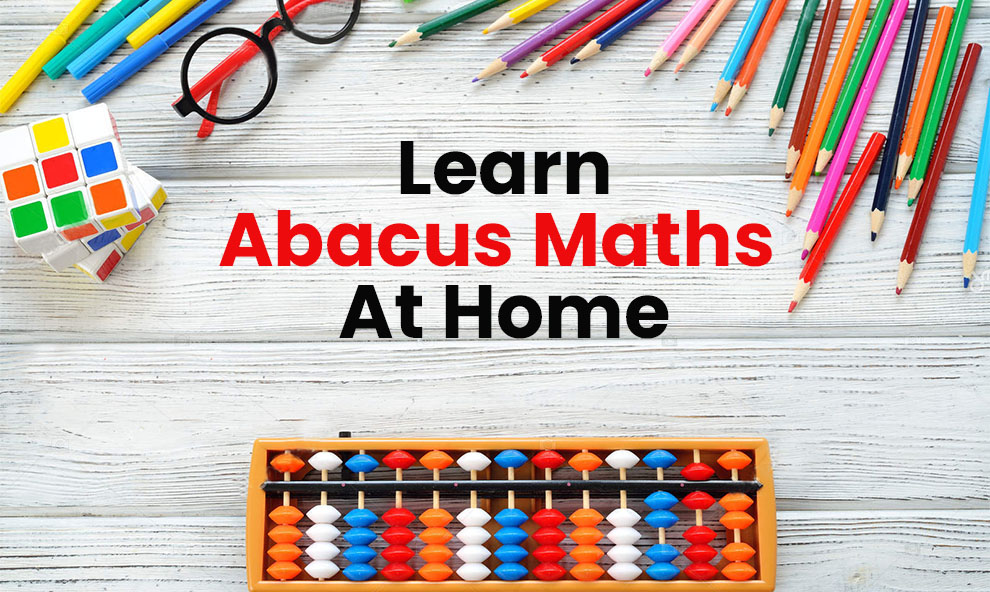The word ‘Abacus’ originates from the Latin Word ‘Abax,’ which stands for ‘a flat surface.’ During olden times, people used to do their calculations by shifting stones and pebbles on a tabletop or any flat surface.
This calculation technique evolved over time and soon used a metal frame containing movable beads. In modern times, children use the same metal frame containing colorful beads to effectively learn addition, subtraction, multiplication and division of large numbers within the blink of an eye!
This tool of learning mathematical operations by shifting beads is known as abacus. Research has shown the efficiency of this method, especially for teaching young children, as the vibrant beads make them visualize better.
The sense of touch used in this method help children treat numbers as non-abstract entities and helps them remember and retain information better.
With the resources available today, the best part is that you can learn, teach, and practice abacus at your homes. You might be wondering, ‘how can I learn abacus at home’? Well! You are in luck.
This article explains how to learn abacus maths at home in detail and answers all relevant questions you might have.
First, let us take a look at some of the benefits of training young children with the abacus.
Jump To
- Benefits Of Abacus
- How To Learn Abacus Easily On Your Own?
- Can Young Children Know How To Learn Abacus At Home?
- FAQs
- Conclusion
Benefits of Abacus
Abacus makes Maths fun and easy for children to grasp. It significantly helps in early brain development and drastically improves a child’s confidence level. Here are some definite benefits of teaching abacus to children:
- Abacus helps in improving a child’s memory, listening skills and concentration ability as they are required to hear and remember information dictated by the teacher continuously.
- A child can solve mathematical problems faster and more accurately than his peers. Consequently, their confidence level is considerably boosted.
- Learning Abacus Maths removes a child’s fear of numbers.
- Abacus makes children visualize numbers, and this makes children understand mathematics more easily than the conventional theoretical approach.
- Children who have learned abacus will be able to spot patterns and series far better than students who have not learned abacus.
- Foundational mathematical operations will be clear to a child, which will help in school and in everyday tasks.
- If your child learns abacus they wouldn’t require calculators for arithmetic calculations while performing complex mathematical equations.
How To Learn Abacus Maths At Home On Your Own?
Now that we have discussed all the pros of learning abacus, the next relevant question is ‘how to learn Abacus easily by ourselves?’ so that we can teach our children or younger siblings.
Learning abacus on your own is not tricky at all. To achieve perfection, all you need to do is dedicate a few hours of your daily time.
Today, there are ample resources online that can help you learn abacus from scratch. These guidelines will help you chalk out a learning path and figure out ‘how to learn Abacus at home’:
Start with reading up on Abacus – Reading about Abacus, its methods, and benefits will give you an insight into the world of Abacus mathematics.
It will serve as an introduction to the abacus and you will be able to determine the next necessary steps in learning further. Several blogs online talk about the advent, advancement, and usefulness of the abacus.
Some also talk about the methods by which you can learn abacus and the applications of abacus in calculations. If you want to delve deep, you can choose to purchase an abacus textbook too!
Begin with small tutorials or YouTube videos on Abacus – After reading about the abacus, you can hop on to YouTube to watch small tutorials that teach you about operating an Abacus.
These tutorials are short and to the point and not much time-consuming. They have been made for newbies to develop an understanding of the features of the abacus.
You will get a brief idea about how to operate an Abacus to perform multiplications and divisions of large numbers. These tutorials will be your guide on how to learn Abacus maths at home.
Buy an Abacus and try it yourself – Once you familiarize yourself with the Abacus frame and learn the functions of the beads, it is now time for you to practice with it.
Try adding and subtracting random numbers using the Abacus frame. Once you become confident, you can take on larger numbers and more complex arithmetic functions and test your knowledge.
‘Learning-by-doing’ has always been a superior method to move forward while acclimatizing yourself with a new skill.
Now take up an online course to learn comprehensively – After you have completed all the steps above, you can consider having a few tricks up your sleeve. An online abacus course not only furthers and enhances your knowledge of the abacus but also teaches you a few shortcuts that will come in handy while calculating or passing on knowledge.
The courses take it from the top and encourage you to build on your fundamentals so that your concept remains clear. These courses teach you how to learn abacus easily and effortlessly.
There are several Ed-Tech platforms that offer courses on the abacus. What course will best suit you depends entirely on your proficiency level, enthusiasm and time. Focus on the user ratings and content before opting for a course.
If you follow these steps mentioned above, then the question ‘How can I learn abacus at home?’ will answer itself.
How To Teach Abacus Math At Home To Young Children?
If you are teaching abacus to someone as young as 5 to 10 years (which is the prime age to learn abacus), they might not be able to comprehend the language written in books or their vernaculars might be different from those used in the acclaimed online courses.
Also, it is highly unlikely that a child that young will have the patience or ability to self-learn through online resources. They are too young to figure out how to learn abacus at home by themselves.
Therefore, it is the responsibility of their elders and teachers to teach them abacus so that their fears of numbers are totally eradicated. Some methods you can adopt to teach abacus to your young ones:
i) Track and imitate the movement method:
In this method, the child is required to keep track of all your moves and then imitate them accurately.
- Place all the beads on one side of the Abacus frame. The other half of the frame shall remain empty initially.
- Shift some beads to the other side and make sure your child repeats the same move with an equal number of beads.
- At first, go one row at a time and then slowly increase the number to 2, 3 or even more rows to see if the child can follow. That is, shift any random number of beads of 3 or more rows together and observe if the toddler does the same without being stuck or confused.
- Do not increase the number of rows if your child is being unable to follow. Do not force the child. Observe how many rows the child is able to imitate correctly and keep shifting the beads of that many rows only till he/she builds enough concentration to move on to the next row.
- If the child enjoys the process and repeats the movements enthusiastically, advance to the next step by rotating sides.
- You have to be patient and slow while teaching this to the kid, especially to toddlers. Make sounds of counting for engaging the child in the process some more.
ii) Counting the beads:
This method entails advancing into mathematical operations like addition and subtraction.
- Make all the beads stay at one side and let the other side remain empty. Now shift any number of beads to the empty side and make sure your child notices how many beads you have shifted and how many beads remain on the other side.
- From the number of beads you have shifted, shift a few beads to the center and ask the child to count the number of beads you have shifted and the number left behind.
- For example, if you shift 6 beads to the right and then remove 2 beads from those 6 beads, the child will have to count the 6 beads first, and then count the 2 beads that have been shifted away and finally count the 4 beads that are left behind. This was a simple process of subtraction; 6-2=4.
- You can also do the same for addition by adding a couple of beads to the other side.
You can teach your child the basics of abacus with these methods. However, for a comprehensive training we suggest you enroll them in a good online course for all-round visual aid training.
FAQs: How To Learn Abacus Easily?
Q. Is it difficult for a child to learn abacus?
Ans: Not at all. With proper encouragement, any child can learn abacus. Once you know how to learn abacus at home it is easy to teach the same to the kids.
Q. At what age should children begin their Abacus training?
Ans: The best age to begin learning abacus is from 5 to 7 years. These are the most crucial years in the brain development of any child. Children are the most receptive in these years.
Q. How long does it take for a child to master abacus?
Ans: Abacus has several levels. Level 1 is for toddlers who are just being introduced to numbers, while the more advanced levels are for students who wish to solve large mathematical operations mentally.
There is no particular parameter for mastering the abacus. The more you practice, the better you get. However, on average, it takes about four months to clearly understand one mental math level. There are 12 such levels.
Conclusion
Learning abacus is excellent for the mental growth of a toddler, and we hope this article has answered all your questions regarding ‘how to learn abacus maths at home’ and ‘how to teach abacus maths at home.
With so much to offer, abacus is a life skill that every child should develop so that they are exposed to a whole new world of opportunities.




